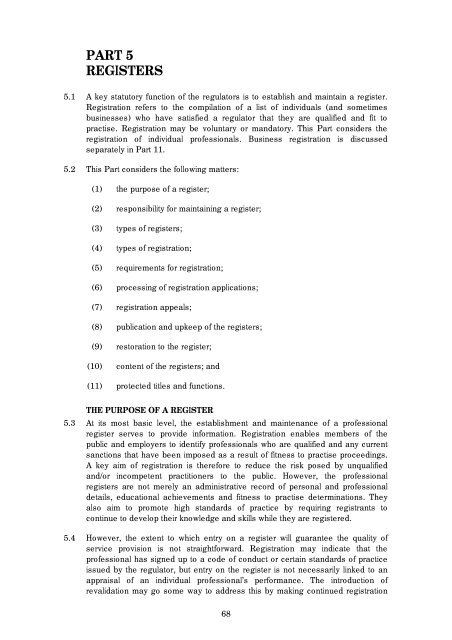Regulation of Health and Social Care Professionals Consultation
Regulation of Health and Social Care Professionals Consultation
Regulation of Health and Social Care Professionals Consultation
You also want an ePaper? Increase the reach of your titles
YUMPU automatically turns print PDFs into web optimized ePapers that Google loves.
PART 5<br />
REGISTERS<br />
5.1 A key statutory function <strong>of</strong> the regulators is to establish <strong>and</strong> maintain a register.<br />
Registration refers to the compilation <strong>of</strong> a list <strong>of</strong> individuals (<strong>and</strong> sometimes<br />
businesses) who have satisfied a regulator that they are qualified <strong>and</strong> fit to<br />
practise. Registration may be voluntary or m<strong>and</strong>atory. This Part considers the<br />
registration <strong>of</strong> individual pr<strong>of</strong>essionals. Business registration is discussed<br />
separately in Part 11.<br />
5.2 This Part considers the following matters:<br />
(1) the purpose <strong>of</strong> a register;<br />
(2) responsibility for maintaining a register;<br />
(3) types <strong>of</strong> registers;<br />
(4) types <strong>of</strong> registration;<br />
(5) requirements for registration;<br />
(6) processing <strong>of</strong> registration applications;<br />
(7) registration appeals;<br />
(8) publication <strong>and</strong> upkeep <strong>of</strong> the registers;<br />
(9) restoration to the register;<br />
(10) content <strong>of</strong> the registers; <strong>and</strong><br />
(11) protected titles <strong>and</strong> functions.<br />
THE PURPOSE OF A REGISTER<br />
5.3 At its most basic level, the establishment <strong>and</strong> maintenance <strong>of</strong> a pr<strong>of</strong>essional<br />
register serves to provide information. Registration enables members <strong>of</strong> the<br />
public <strong>and</strong> employers to identify pr<strong>of</strong>essionals who are qualified <strong>and</strong> any current<br />
sanctions that have been imposed as a result <strong>of</strong> fitness to practise proceedings.<br />
A key aim <strong>of</strong> registration is therefore to reduce the risk posed by unqualified<br />
<strong>and</strong>/or incompetent practitioners to the public. However, the pr<strong>of</strong>essional<br />
registers are not merely an administrative record <strong>of</strong> personal <strong>and</strong> pr<strong>of</strong>essional<br />
details, educational achievements <strong>and</strong> fitness to practise determinations. They<br />
also aim to promote high st<strong>and</strong>ards <strong>of</strong> practice by requiring registrants to<br />
continue to develop their knowledge <strong>and</strong> skills while they are registered.<br />
5.4 However, the extent to which entry on a register will guarantee the quality <strong>of</strong><br />
service provision is not straightforward. Registration may indicate that the<br />
pr<strong>of</strong>essional has signed up to a code <strong>of</strong> conduct or certain st<strong>and</strong>ards <strong>of</strong> practice<br />
issued by the regulator, but entry on the register is not necessarily linked to an<br />
appraisal <strong>of</strong> an individual pr<strong>of</strong>essional’s performance. The introduction <strong>of</strong><br />
revalidation may go some way to address this by making continued registration<br />
68
















